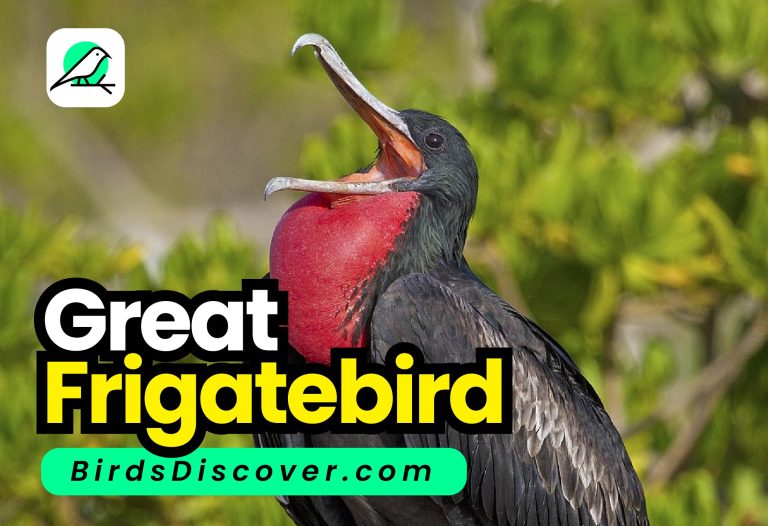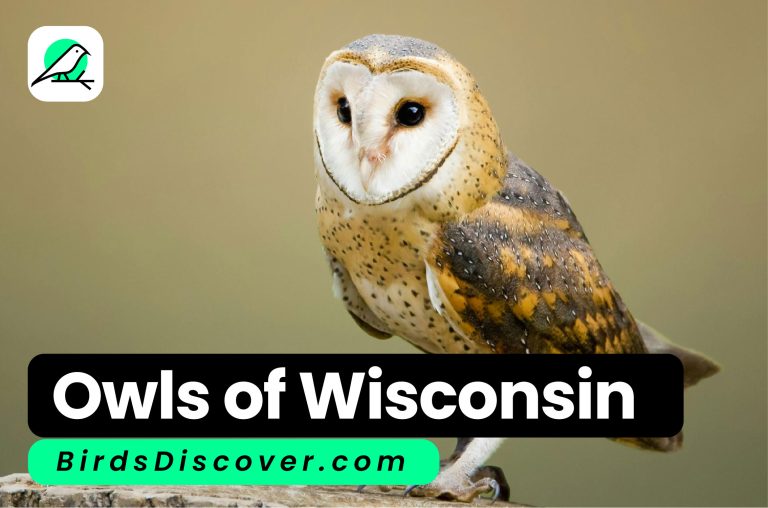17 Green Birds as Symbols of Nature’s Beauty

Green Birds
Green birds, found across diverse habitats, are admired for their vivid and captivating green plumage, distinguishing them from other avian species and enhancing their aesthetic appeal.
Among these avian wonders is the bee hummingbird, recognized as the world’s tiniest green bird, weighing a mere 1.6 grams, yet capable of soaring to heights nearing 3,000 meters (10,000 feet) during flight.
Contrastingly, the hyacinth macaw, the largest of its green-feathered counterparts, can tip the scales at up to 1.5 kilograms. Despite its substantial size, it shares a comparable maximum flight altitude of around 3,000 meters (10,000 feet) above sea level.
| Bird Name | Description |
|---|---|
| Amazon Parrots | Various parrot species found in the Amazon rainforest. |
| Green Broadbill | Found in Southeast Asia, known for its broad bill. |
| Green Parakeet | Small parrot species with predominantly green plumage. |
| Violet-Green Swallow | Small swallow species with iridescent green and violet hues. |
| Green-Winged Teal | A dabbling duck species with green wing patches. |
| Puerto Rican Tody | Small bird species endemic to Puerto Rico. |
| Green Honeycreeper | Found in tropical forests, known for its brilliant green plumage. |
| Green Catbird | Native to Australia and New Guinea, known for its green plumage. |
| Double-eyed Fig Parrot | Small parrot species found in Australia and nearby islands. |
| Pacific Parrotlet | Small parrot species native to Central and South America. |
| Resplendent Quetzal | Found in Central and South America, known for its vibrant green plumage. |
| Eclectus Parrot | Sexually dimorphic parrot species with green and red plumage. |
| Green Jay | Native to Central and South America, known for its vivid green, blue, and black plumage. |
| Green Cheek Conure | Small parrot species with green cheeks, native to South America. |
| Green Turaco | Native to Africa, known for its iridescent green plumage. |
| Green Aracari | A small toucan species found in the Amazon rainforest. |
| Green-Winged Macaw | Large parrot species with green wings, native to South America. |
Key Points of Green Birds
- Green birds are notable for their striking and often vibrant green plumage, setting them apart from many other avian species.
- These birds can be found in various habitats worldwide, from tropical rainforests to temperate woodlands, showcasing their adaptability.
- Green birds play diverse ecological roles, from pollination (as seen in hummingbirds) to seed dispersal and insect control.
- Some iconic green bird species include parrots, parakeets, hummingbirds, and toucans, each with unique behaviors and adaptations.
- Green birds are often sought after by birdwatchers and enthusiasts due to their beauty and the challenge they pose in spotting them in their natural habitats.
Amazon Parrot
Amazon Parrots, belonging to the genus Amazona, are colorful and intelligent parrot species native to the Americas. Renowned for their vibrant plumage and remarkable vocalizations, they inhabit tropical and subtropical forests. These social birds exhibit playful behavior and are often kept as pets, contributing to their conservation challenges.
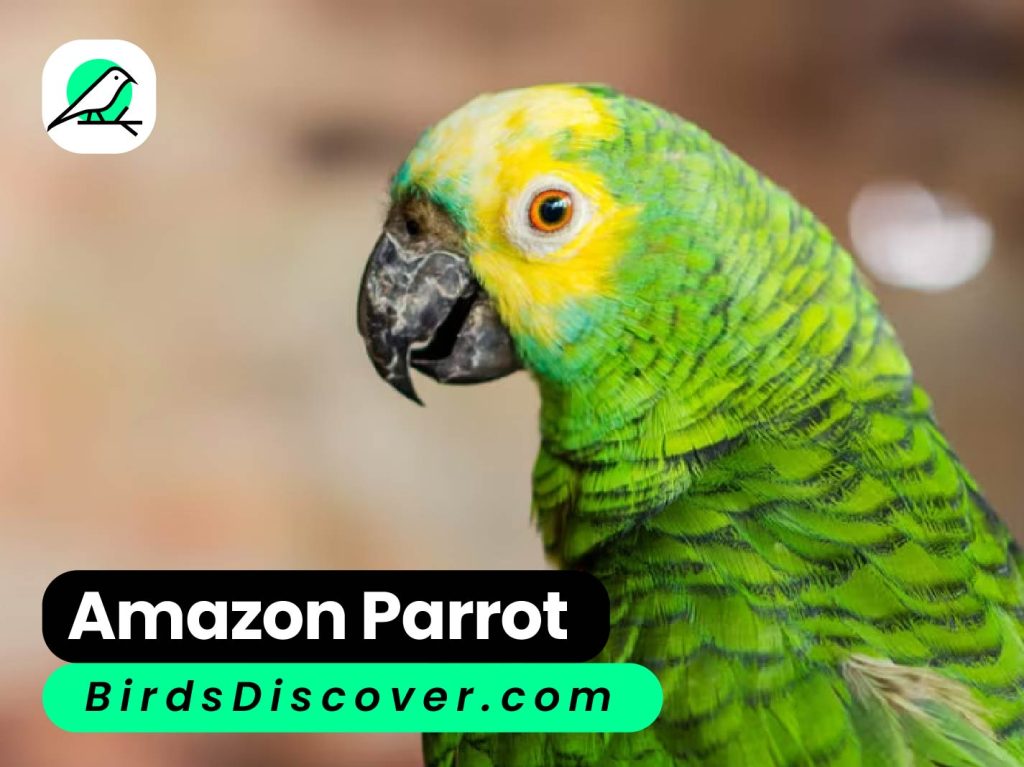
Amazon Parrot Biography, Sound
| Aspect | Description |
|---|---|
| Taxonomy | Genus: Amazona Family: Psittacidae (Parrots) |
| Habitat | Tropical and subtropical forests of Central and South America |
| Size | Medium to large-sized birds, ranging from 10 to 18 inches in length |
| Weight | Typically weighing between 250 to 700 grams |
| Plumage | Varied colors, predominantly green with accents of red, blue, yellow, and orange |
| Lifespan | Can live up to 50 to 60 years in captivity, with some reports of even longer lifespans |
| Diet | Omnivorous, feeding primarily on fruits, nuts, seeds, flowers, and occasional insects |
| Social Structure | Social birds, often found in flocks ranging from a few individuals to hundreds |
| Behavior | Intelligent and curious, known for their playful antics and ability to mimic human speech and environmental sounds |
| Reproduction | Monogamous breeders, forming strong pair bonds; typically lay 2 to 4 eggs per clutch |
| Conservation Status | Varies among species, with some facing threats such as habitat loss, illegal trapping for the pet trade, and fragmentation of populations |
Facts about Amazon Parrots:
- There are over 30 species of Amazon parrots, each with unique characteristics and distributions.
- Amazon parrots are renowned for their exceptional vocal abilities, capable of mimicking a wide range of sounds, including human speech.
- Some species, such as the Yellow-headed Amazon and the Blue-fronted Amazon, are popular as pets due to their striking appearance and engaging personalities.
- In the wild, Amazon parrots play crucial roles in seed dispersal and forest regeneration through their feeding habits.
- Habitat loss and illegal trapping for the pet trade pose significant threats to many Amazon parrot species, leading to declines in wild populations.
Green Broadbill
The Green Broadbill, Calyptomena viridis, a jewel of Southeast Asian forests, boasts vibrant emerald plumage and a distinctive broad beak. Its melodious calls and agile aerial feats charm forest dwellers. Feeding on insects and fruits, it plays a vital ecological role. Conservation efforts sustain its least concern status amid habitat threats.
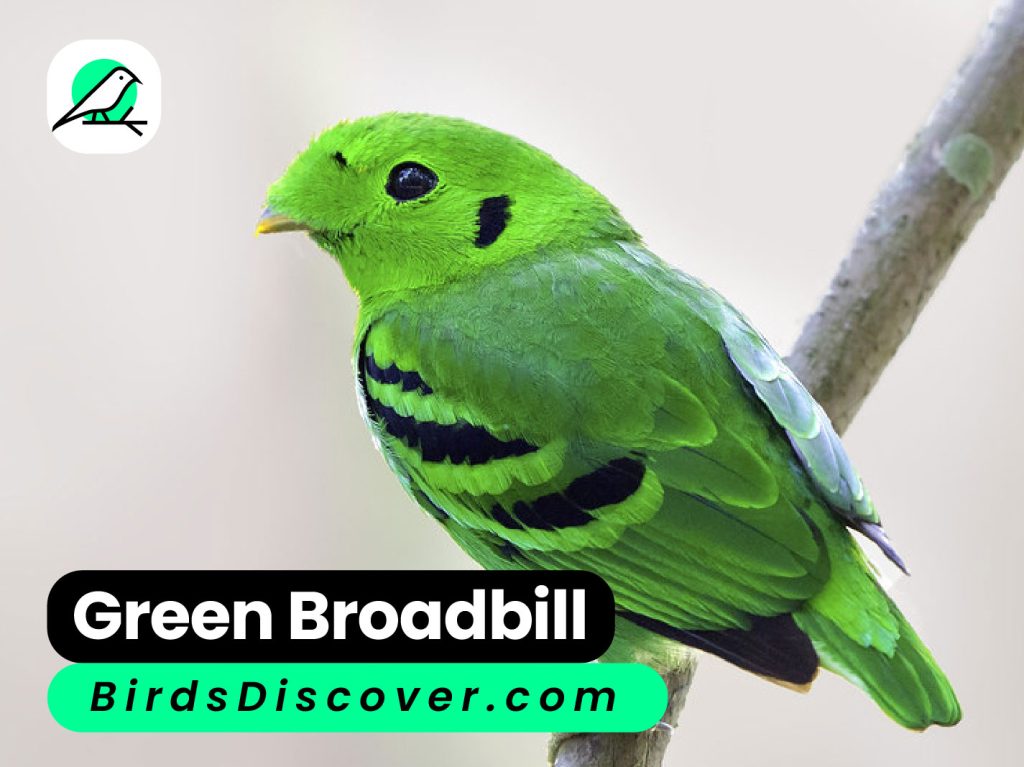
Green Broadbill Biography, Sound
| Aspect | Description |
|---|---|
| Name | Green Broadbill |
| Scientific Name | Calyptomena viridis |
| Habitat | Dense forests of Southeast Asia |
| Lifespan | 7 to 10 years |
| Diet | Insects, small fruits |
| Behavior | Melodious calls, agile aerial maneuvers |
| Reproduction | Nests constructed in dense foliage, eggs incubated by both parents |
| Conservation Status | Least Concern |
| Description | Striking emerald plumage, distinctive broad beak |
| Ecological Role | Vital in maintaining forest ecosystem balance, contributes to pollination and seed dispersal |
| Threats | Habitat loss due to deforestation, fragmentation of forests, and illegal wildlife trade |
| Conservation Efforts | Protected area management, habitat restoration projects, and community-based conservation initiatives |
Green Parakeet
The Green Parakeet, a charismatic avian species, showcases vibrant green plumage and a sociable demeanor. Found across Central and South America, it thrives in diverse habitats, from forests to urban areas. With a varied diet and gregarious nature, it adds color and vitality to its surroundings.

Green Parakeet Biography, Sound
| Aspect | Description |
|---|---|
| Name | Green Parakeet |
| Scientific Name | Psittacara holochlorus |
| Habitat | Varied habitats including forests, woodlands, savannas, and urban areas |
| Range | Central and South America, including countries like Mexico, Venezuela, Brazil, and Argentina |
| Diet | Omnivorous, feeding on fruits, seeds, nuts, berries, flowers, and occasional insects |
| Behavior | Highly social, forming large flocks, often noisy and gregarious, with strong pair bonds during breeding |
| Reproduction | Nests in tree cavities or nest boxes, lays clutches of 3-5 eggs, both parents participate in incubation |
| Conservation Status | Least Concern |
| Description | Vibrant green plumage with accents of yellow, blue, and red, medium-sized parrot with a long, tapered tail |
| Ecological Role | Plays a role in seed dispersal and maintaining forest ecosystems |
| Threats | Habitat loss due to deforestation and urbanization, illegal trapping for the pet trade, and predators |
| Conservation Efforts | Habitat preservation, conservation of nesting sites, and regulation of the pet trade |
Violet-Green Swallow
The Violet-green Swallow, Tachycineta thalassina, is a graceful aerial acrobat found in North America. With iridescent violet and green plumage, it dazzles as it swoops through the sky, catching insects on the wing. These agile birds nest in tree cavities, adding beauty and vitality to their woodland habitats.

Violet-Green Swallow Biography, Sound
| Attribute | Description |
|---|---|
| Common Name | Violet-green Swallow |
| Scientific Name | Tachycineta thalassina |
| Family | Hirundinidae |
| Size | Small-sized swallow, typically around 12-15 cm (4.7-5.9 inches) in length |
| Weight | Approximately 14-18 grams (0.5-0.6 ounces) |
| Plumage | Iridescent violet and green upperparts with white underparts and a slightly forked tail |
| Bill | Short and pointed, typically black in color |
| Range | Found in western North America, from Alaska to Mexico, and parts of Central America |
| Habitat | Prefers open woodlands, forest edges, meadows, and urban areas |
| Behavior | Highly aerial and agile, often seen catching insects on the wing, forms loose colonies during breeding season |
| Diet | Insectivorous, feeding primarily on flying insects such as flies, beetles, and mosquitoes |
| Breeding | Monogamous breeders, nesting in tree cavities or artificial nest boxes, typically in colonies |
| Conservation Status | Least Concern (population stable, widespread, and not facing significant threats) |
Green-Winged Teal
The Green-winged Teal, Anas crecca, is a small dabbling duck native to North America. Named for its vibrant green wing patch, it sports intricate plumage with a distinctive chestnut head. Often found in shallow wetlands and marshes, these ducks forage for seeds, plants, and aquatic invertebrates, contributing to wetland ecosystems.

Green-Winged Teal Biography, Sound
| Attribute | Description |
|---|---|
| Common Name | Green-winged Teal |
| Scientific Name | Anas crecca |
| Family | Anatidae |
| Size | Small-sized dabbling duck, typically around 30-40 cm (12-16 inches) in length |
| Weight | Approximately 240-450 grams (8.5-16 ounces) |
| Plumage | Male has a chestnut-colored head with a distinctive green patch on the wing; female has mottled brown plumage |
| Bill | Short and pointed, typically dark in color |
| Range | Found in North America, Europe, Asia, and parts of Africa, breeding in northern latitudes and wintering further south |
| Habitat | Prefers shallow wetlands, marshes, ponds, lakes, and coastal estuaries |
| Behavior | Often seen in small flocks, foraging for aquatic plants, seeds, insects, and crustaceans in shallow waters |
| Diet | Omnivorous, feeding primarily on seeds, aquatic plants, insects, and small invertebrates |
| Breeding | Monogamous breeders, nesting on the ground in dense vegetation, typically concealed near water |
| Conservation Status | Least Concern (population stable, widespread, and not facing significant threats) |
Puerto Rican Tody
The Puerto Rican Tody, Todus mexicanus, is a tiny jewel of the Caribbean forests. With its vibrant green plumage and oversized head, it flits through dense foliage, feeding on insects. Endemic to Puerto Rico, this charismatic bird adds color and charm to its tropical habitat with its distinctive appearance and behavior.

Puerto Rican Tody Biography, Sound
| Attribute | Description |
|---|---|
| Common Name | Puerto Rican Tody |
| Scientific Name | Todus mexicanus |
| Family | Todidae |
| Size | Small-sized bird, typically around 10 cm (4 inches) in length |
| Weight | Approximately 5-7 grams (0.2-0.25 ounces) |
| Plumage | Bright green overall plumage with a red throat patch in males |
| Bill | Short and stout, slightly curved, usually black in color |
| Range | Endemic to Puerto Rico in the Caribbean |
| Habitat | Prefers lush tropical forests, particularly montane and foothill forests |
| Behavior | Highly active and territorial, often seen perched on branches while hunting for insects |
| Diet | Insectivorous, feeding primarily on small insects such as beetles, ants, and caterpillars |
| Breeding | Monogamous breeders, constructing dome-shaped nests in tree cavities or banks |
| Conservation Status | Near Threatened (due to habitat loss and degradation, as well as introduced predators) |
Green Honeycreeper
The Green Honeycreeper, native to Central and South America, is a small, vibrant bird adorned in brilliant green plumage with a contrasting black mask around its eyes. Males sport a stunning turquoise-blue crown. They primarily feed on fruits and insects, contributing to the diversity of tropical ecosystems.

Green Honeycreeper Biography, Sound
| Attribute | Description |
|---|---|
| Scientific Name | Chlorophanes spiza |
| Family | Thraupidae |
| Habitat | Tropical forests and woodlands of Central and South America |
| Diet | Primarily fruits, also feeds on insects |
| Size | Approximately 12-13 centimeters in length |
| Plumage | Brilliant green with a turquoise-blue crown in males |
| Behavior | Often found in small groups, foraging in the canopy |
| Conservation | Populations stable; not currently considered threatened |
Green Catbird
The Green Catbird, endemic to Australia, is a secretive bird known for its vibrant green plumage and cat-like calls. It dwells in dense forests and thickets, where it forages for fruits and insects. Despite its name, it’s not closely related to true catbirds but belongs to the bowerbird family.
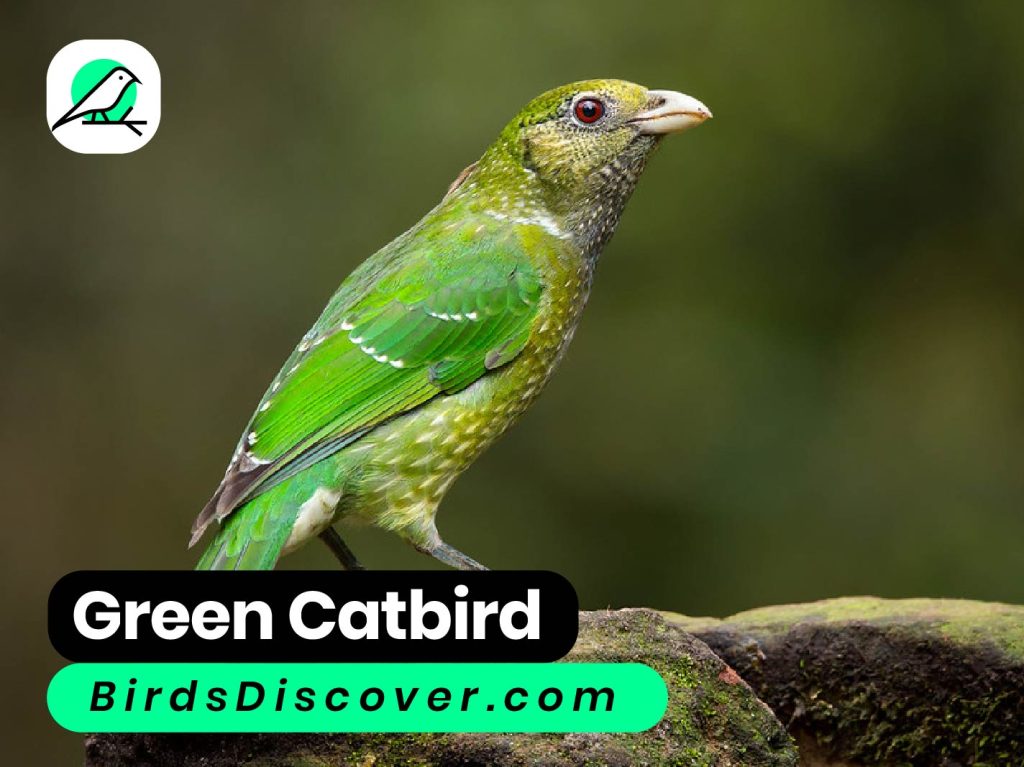
Green Catbird Biography, Sound
| Attribute | Description |
|---|---|
| Scientific Name | Ailuroedus crassirostris |
| Family | Ptilonorhynchidae |
| Habitat | Dense forests and thickets of eastern Australia |
| Diet | Omnivorous, feeding on fruits, insects, and small animals |
| Size | Approximately 24-26 centimeters in length |
| Plumage | Vibrant green with a paler underside |
| Vocalization | Known for its distinctive cat-like calls |
| Conservation | Population stable; not considered threatened |
Double-eyed Fig Parrot
The Double-eyed Fig Parrot, endemic to Australia, is a diminutive and colorful bird renowned for its vibrant green plumage and distinctive red patch around its eyes. It primarily feeds on figs and inhabits tropical and subtropical rainforests, contributing to seed dispersal within its ecosystem.
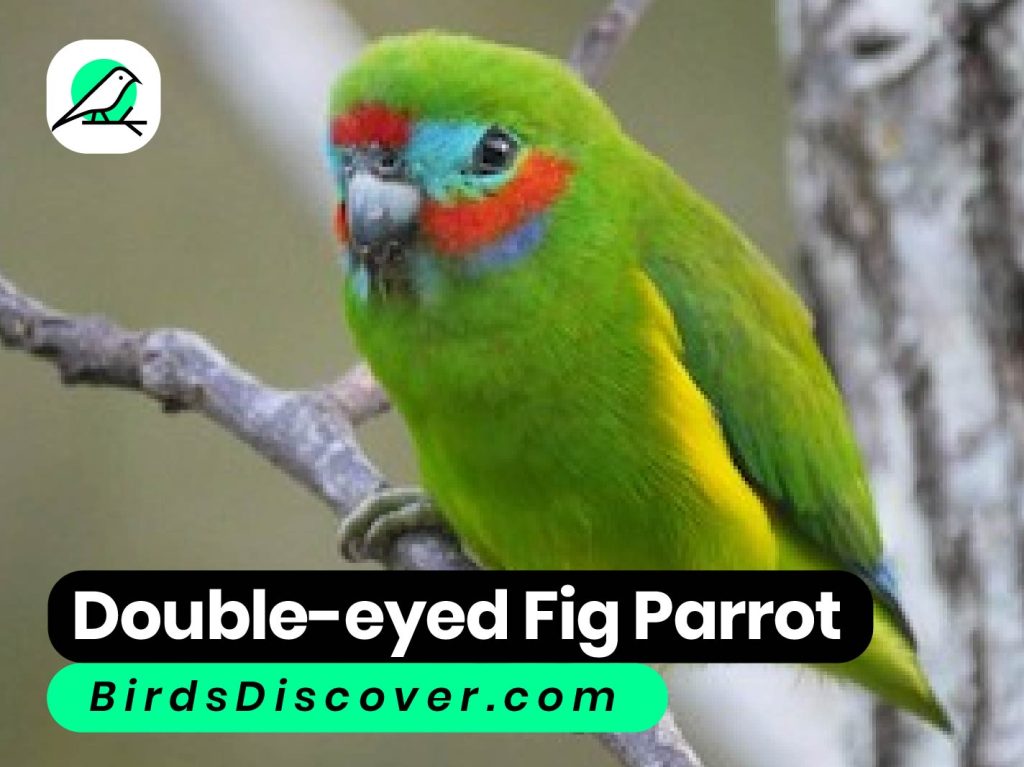
Double-eyed Fig Parrot Biography,Sound
| Attribute | Description |
|---|---|
| Scientific Name | Cyclopsitta diophthalma |
| Family | Psittaculidae |
| Habitat | Tropical and subtropical rainforests of northeastern Australia |
| Diet | Primarily feeds on figs, occasionally consumes other fruits |
| Size | Small parrot, around 15-18 centimeters in length |
| Plumage | Vibrant green with a distinctive red patch around each eye |
| Behavior | Typically seen in pairs or small flocks, active during the day |
| Conservation | Vulnerable due to habitat loss and fragmentation |
Pacific Parrotlet
The Pacific Parrotlet, native to South and Central America, is one of the smallest parrot species, measuring just 10 centimeters in length. Despite its diminutive size, it boasts vibrant plumage, ranging from bright green to cobalt blue. These social birds exhibit playful behavior and form strong bonds with their owners.
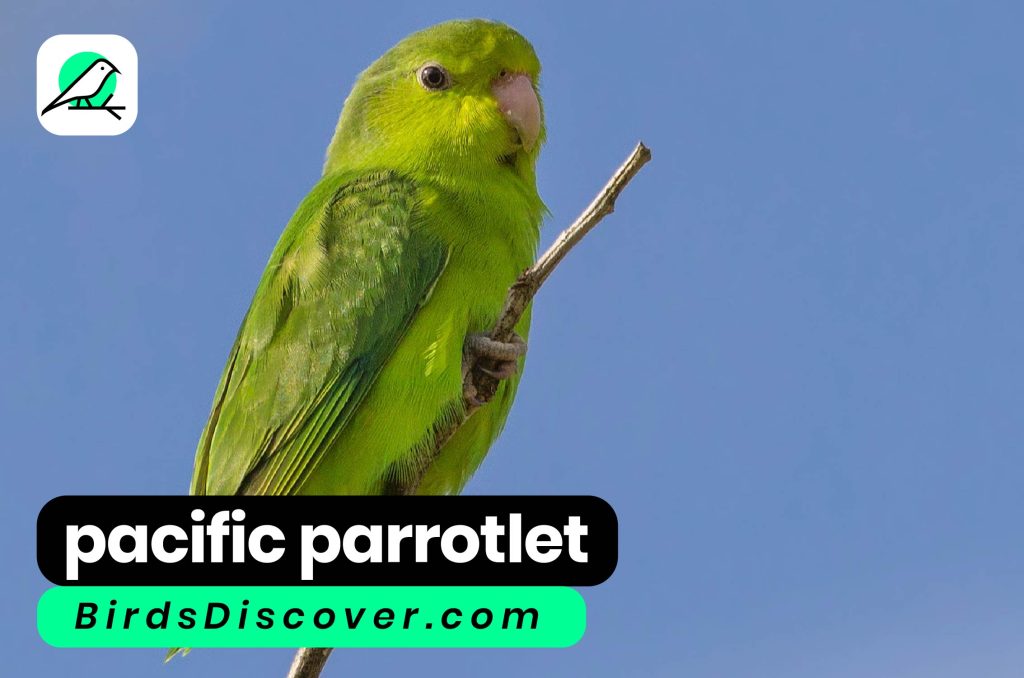
Pacific Parrotlet Biography, Sound
| Attribute | Description |
|---|---|
| Scientific Name | Forpus coelestis |
| Family | Psittacidae |
| Habitat | Native to South and Central America, inhabiting forests and scrublands |
| Diet | Omnivorous, consuming seeds, fruits, and occasionally insects |
| Size | One of the smallest parrot species, around 10 centimeters in length |
| Plumage | Vibrant colors ranging from bright green to cobalt blue |
| Behavior | Social and playful, forms strong bonds with owners |
| Conservation | Populations stable; not considered threatened |
Resplendent Quetzal
The Resplendent Quetzal, revered in Mayan and Aztec cultures, is a striking bird found in the cloud forests of Central America. Its iridescent green plumage, long tail feathers, and crimson breast make it an emblem of beauty. Known for its elusive nature, it feeds primarily on fruits and insects.
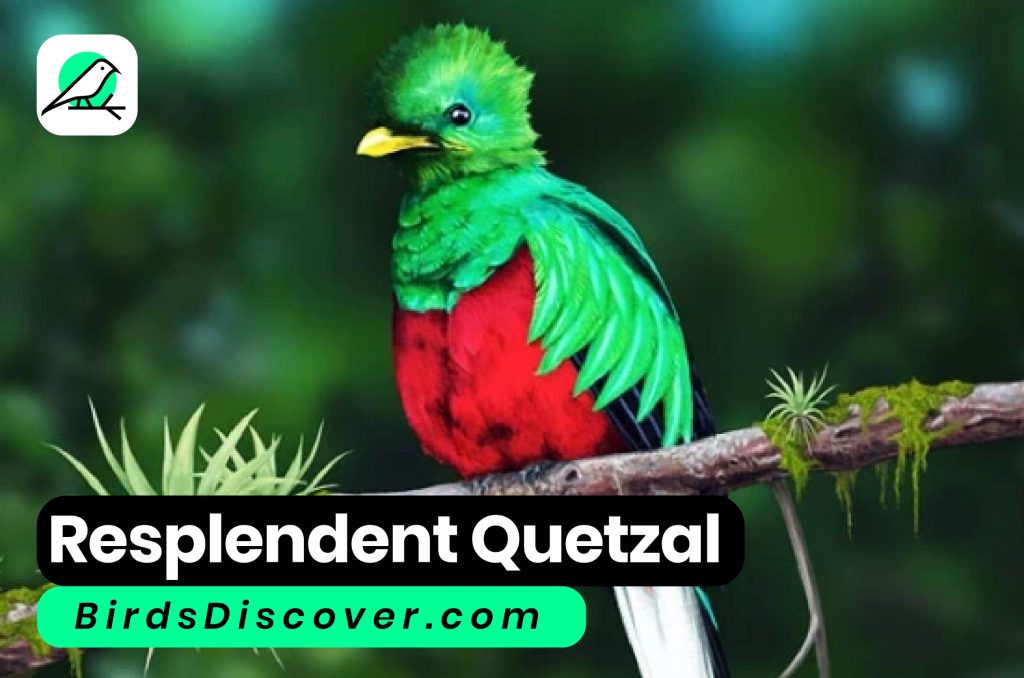
Resplendent Quetzal Biography, Sound
| Attribute | Description |
|---|---|
| Scientific Name | Pharomachrus mocinno |
| Family | Trogonidae |
| Habitat | Found in cloud forests of Central America, ranging from southern Mexico to Panama |
| Diet | Primarily feeds on fruits, insects, and occasionally small reptiles and amphibians |
| Size | Medium-sized bird, approximately 36-40 centimeters in length |
| Plumage | Iridescent green with a crimson breast and long, elegant tail feathers |
| Behavior | Solitary or seen in pairs during breeding season, often elusive and difficult to spot |
| Conservation | Near Threatened due to habitat loss and illegal poaching |
Eclectus Parrot
The Eclectus Parrot, native to the tropical forests of New Guinea and nearby islands, is famed for its extreme sexual dimorphism: males are vivid green while females are bright red and blue. Their elegant appearance, sharp intellect, and gentle demeanor make them popular companions in aviculture.
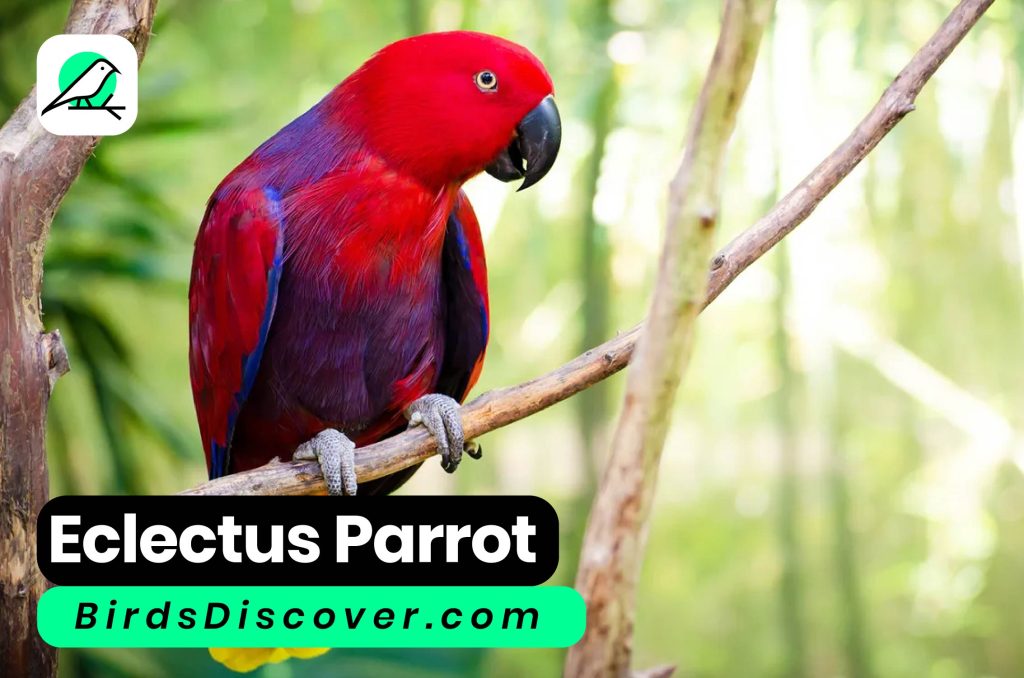
| Attribute | Description |
|---|---|
| Scientific Name | Eclectus roratus |
| Family | Psittaculidae |
| Habitat | Native to tropical forests of New Guinea and nearby islands |
| Diet | Omnivorous, feeding on fruits, seeds, nuts, and blossoms |
| Size | Medium to large parrot species, with males and females differing significantly in appearance |
| Plumage | Extreme sexual dimorphism: males are predominantly green, females are bright red and blue |
| Behavior | Social and intelligent birds, known for their gentle demeanor and strong bond with owners |
| Conservation | Not considered threatened; stable populations in the wild |
Green Jay
The Green Jay (Cyanocorax yncas) is a brilliantly colored bird found in Central America and parts of Mexico. Sporting vibrant green plumage, black facial markings, and blue and yellow accents, it is a sight to behold. Known for its intelligence and mischievous nature, it thrives in a variety of habitats, from forests to urban areas.
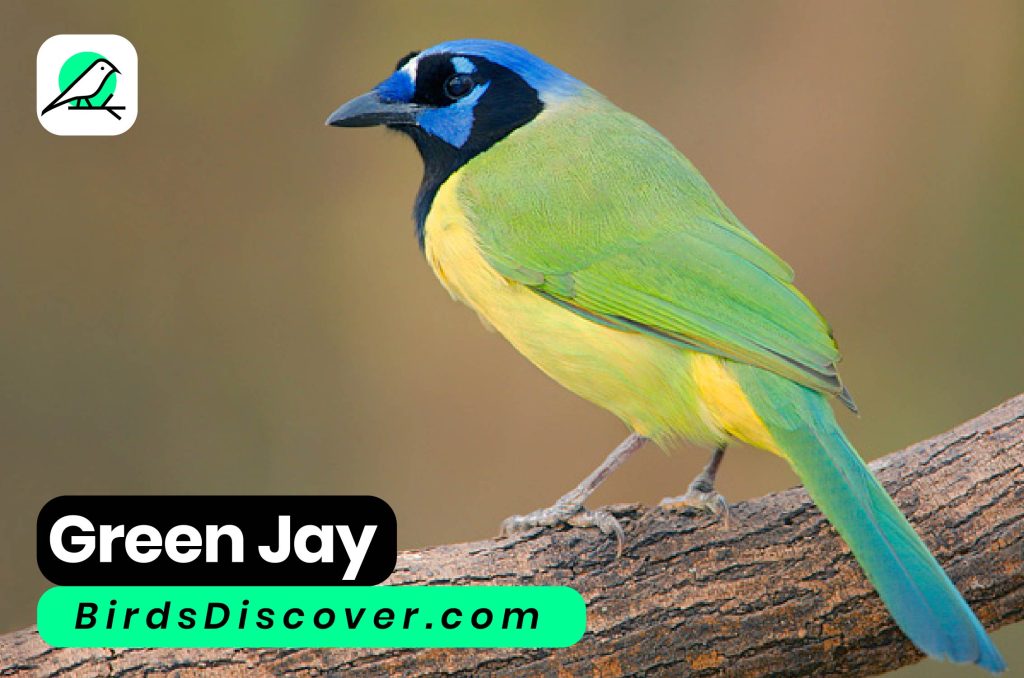
Green jay Biography, Sound
| Attribute | Description |
|---|---|
| Scientific Name | Cyanocorax yncas |
| Common Name | Green Jay |
| Habitat | Forests, woodlands, scrublands, gardens, urban areas |
| Range | Central America and parts of Mexico |
| Plumage | Brilliant green with black facial markings, blue and yellow accents |
| Behavior | Highly intelligent and social, known for its vocalizations and playful antics |
| Diet | Omnivorous, feeding on fruits, insects, small vertebrates, eggs, and occasionally nectar |
| Conservation | Not globally threatened, though habitat loss and fragmentation pose localized threats |
| Interesting Fact | Green Jays are known to form cooperative breeding groups, with multiple family members helping to raise offspring. |
Green Cheek Conure
The Green Cheek Conure (Pyrrhura molinae) is a small parrot native to South America. With vibrant green plumage, red tail feathers, and a distinctive dark head cap, it’s a popular choice among bird enthusiasts. Known for their playful and affectionate nature, they make charming companions in captivity.

Green Cheek Conure Biography, Sound
| Attribute | Description |
|---|---|
| Scientific Name | Pyrrhura molinae |
| Common Name | Green Cheek Conure |
| Origin | South America, primarily in Brazil, Bolivia, Argentina, and Paraguay |
| Size | Small, typically 10-11 inches (25-28 cm) in length |
| Plumage | Mainly green with a brownish-gray head, red tail feathers, and blue primary flight feathers |
| Lifespan | 10-30 years in captivity, depending on care and genetics |
| Diet | Omnivorous, consuming a variety of seeds, fruits, vegetables, and occasionally insects |
| Behavior | Playful, social, and intelligent; known for their acrobatic antics and ability to mimic sounds |
| Conservation | Not globally threatened, though habitat loss and trapping for the pet trade are potential concerns |
| Interesting Fact | Green Cheek Conures are highly social birds and thrive in the company of humans and other birds. |
Green Turaco
The Green Turaco (Tauraco persa), also known as the Green-crested Turaco, is a striking bird native to sub-Saharan Africa. Its vivid green plumage, contrasting red and white facial markings, and unique crest make it a captivating sight. With a diet consisting mainly of fruits, it plays a crucial role in seed dispersal.
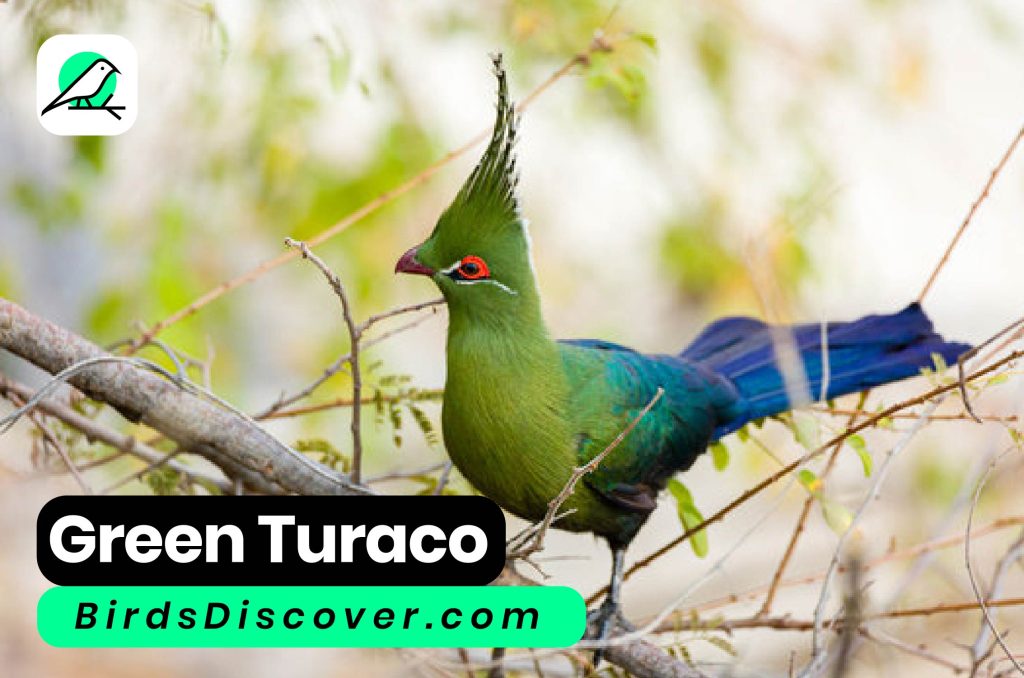
Green Turaco Biography, Sound
| Attribute | Description |
|---|---|
| Scientific Name | Tauraco persa |
| Common Name | Green Turaco, Green-crested Turaco |
| Habitat | Tropical forests and woodlands of sub-Saharan Africa |
| Range | Found in countries including Nigeria, Cameroon, Ghana, and the Democratic Republic of the Congo |
| Plumage | Vibrant green with contrasting red and white facial markings, and a distinctive green crest |
| Size | Medium-sized, typically 40-50 cm (16-20 inches) in length |
| Diet | Mainly frugivorous, feeding on fruits, berries, and occasionally insects |
| Behavior | Arboreal and generally shy, often seen in pairs or small groups; known for their distinctive calls |
| Conservation | Generally stable populations; habitat loss and trapping for the pet trade are localized threats |
| Interesting Fact | Green Turacos play a vital role in forest ecosystems by dispersing seeds of the fruits they consume. |
Green Aracari
The Green Aracari (Pteroglossus viridis) is a stunning toucan species found in the forests of South America. With its emerald green plumage, vivid yellow markings, and distinctive red band across its chest, it’s a sight to behold. Feeding mainly on fruits, it contributes to forest regeneration through seed dispersal.
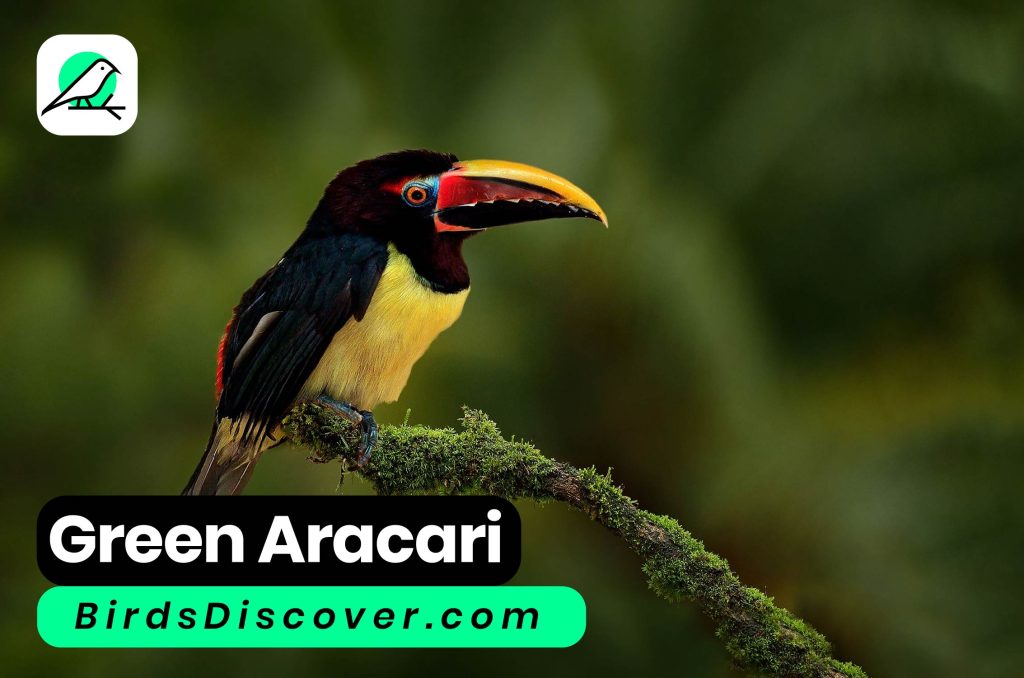
Green Aracari Biography,Sound
| Attribute | Description |
|---|---|
| Scientific Name | Pteroglossus viridis |
| Common Name | Green Aracari |
| Habitat | Tropical rainforests and humid forests of South America, primarily in the Amazon Basin |
| Range | Found in countries including Brazil, Peru, Ecuador, Bolivia, and Colombia |
| Plumage | Emerald green with yellow markings on the face, chest, and bill; red band across the chest |
| Size | Small to medium-sized, typically 30-40 cm (12-16 inches) in length |
| Diet | Primarily frugivorous, feeding on a variety of fruits, as well as insects and small vertebrates |
| Behavior | Social and arboreal, often seen in pairs or small groups; known for their distinctive calls |
| Conservation | Generally stable populations; threats include habitat loss and fragmentation |
| Interesting Fact | Green Aracaris play a vital role in forest ecosystems by dispersing seeds through their diet. |
Green-Winged Macaw
The Green-Winged Macaw (Ara chloropterus) is a magnificent parrot species native to South America. Distinguished by vibrant green plumage with a splash of red, it’s one of the largest parrots in the world. Highly intelligent and social, it forms strong bonds with its flock and human companions.
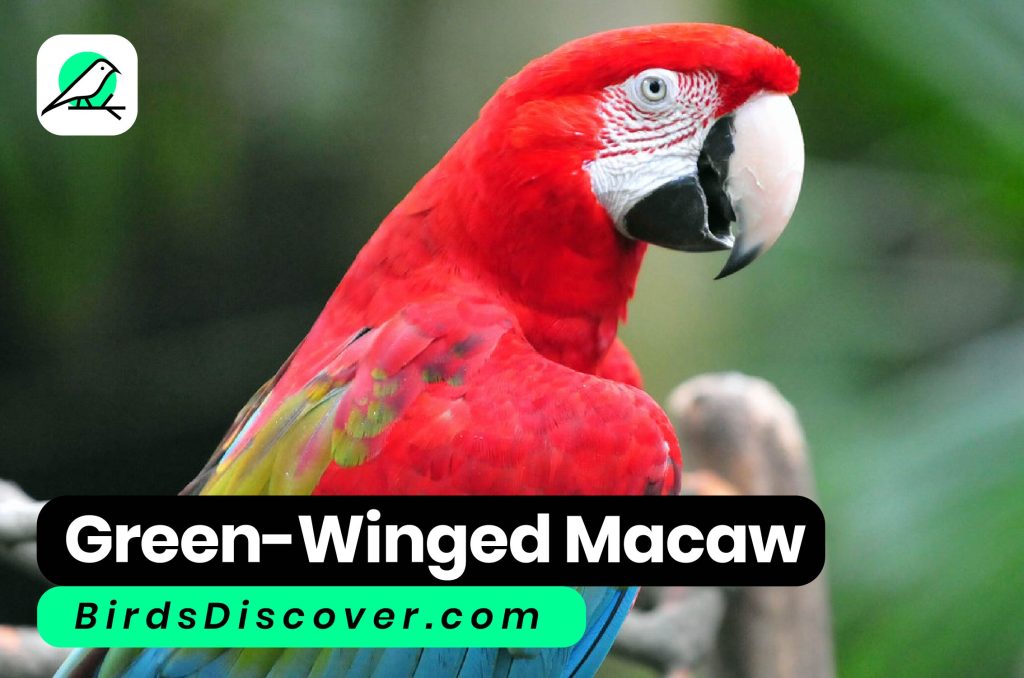
Green-Winged Macaw Biography, Sound
| Attribute | Description |
|---|---|
| Scientific Name | Ara chloropterus |
| Common Name | Green-Winged Macaw |
| Habitat | Tropical forests and woodlands of South America, primarily in the Amazon Basin and parts of Brazil |
| Range | Found in countries including Brazil, Bolivia, and Paraguay |
| Plumage | Vibrant green with blue and red accents; distinctive green feathers on the wings |
| Size | Large, typically 75-90 cm (30-36 inches) in length |
| Diet | Omnivorous, consuming fruits, nuts, seeds, and occasionally insects |
| Behavior | Intelligent, social, and affectionate; often forms strong bonds with humans and other macaws |
| Conservation | Vulnerable due to habitat loss, illegal trapping for the pet trade, and poaching |
| Interesting Fact | Green-Winged Macaws are known for their loud calls and impressive vocalizations, used for communication within their flock. |

